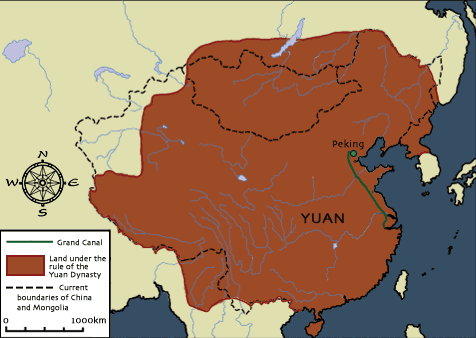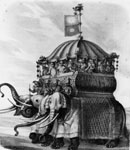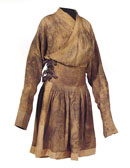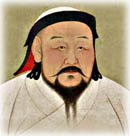Chinese Culture >> Chinese Dynasty >> Yuan Dynasty
Yuan Dynasty Background (Year: 1279 - 1368)
 In
the year 1279 the Yuan dynasty was founded. While time of Mongol rule is called
a dynasty, it was in fact a government of occupation. While the Mongols did use
existing governmental structures for the duration, the language they used was
Mongol, and many of the officials they used were non-Chinese. Mongols, Uighurs
from central Asia, some Arabs and even an Italian named Marco Polo all served as
officials for the Mongol government. One of the more significant accomplishments
of the Mongol tenure was the preservation of China as we know it in that China
wasn't turned into pastureland for the Mongolian ponies which not only was
common Mongolian practice for territories they'd overrun but had actually been
advocated by some of the conquering generals.
In
the year 1279 the Yuan dynasty was founded. While time of Mongol rule is called
a dynasty, it was in fact a government of occupation. While the Mongols did use
existing governmental structures for the duration, the language they used was
Mongol, and many of the officials they used were non-Chinese. Mongols, Uighurs
from central Asia, some Arabs and even an Italian named Marco Polo all served as
officials for the Mongol government. One of the more significant accomplishments
of the Mongol tenure was the preservation of China as we know it in that China
wasn't turned into pastureland for the Mongolian ponies which not only was
common Mongolian practice for territories they'd overrun but had actually been
advocated by some of the conquering generals.

The Mongols divided the people in China into four classes. The first class were the Mongols, the next class were other peoples who were not Chinese, the third class were North Chinese and the last class were the South Chinese. The Mongols held the South Chinese for barbarian, but they were much better educated than the Mongols.
AdvertisementThe Yuan dynasty also featured the famous Khubilai Khan, who, among other things, extended the Grand Canal. In the year 1267 Kubilai Khan shift the capital from Karakorum to Beijing. While in many ways, the Yuan Dynasty was a disaster, the reluctance of the Mongols to hire educated Chinese for governmental posts resulted in a remarkable cultural flowering; for example, Beijing Opera was invented during the Yuan Dynasty. On the other hand, attempts to analyze the failure of the Song Dynasty in keeping barbarians out China led to the rise and dominance of Neo-Confucianism, a notoriously conservative (if not outright reactionary) brand of Confucianism that had originally developed during the Song Dynasty.
The sciences were continued during the Yuan dynasty. The main sciences were mathematics and astronomy. The Yuan dynasty always tried to promote religions in which they were interested.
Click on pictures below to enlarge.
Chinese Dynasty Quick Links
Tang Dynasty Xia DynastyWestern Zhou Dynasty Eastern Zhou Dynasty Shang Dynasty Qin Dynasty Han Dynasty Three Kingdom Dynasty Sui Dynasty Song Dynasty Yuan Dynasty Ming Dynasty Qing Dynasty Early 20th Century China



